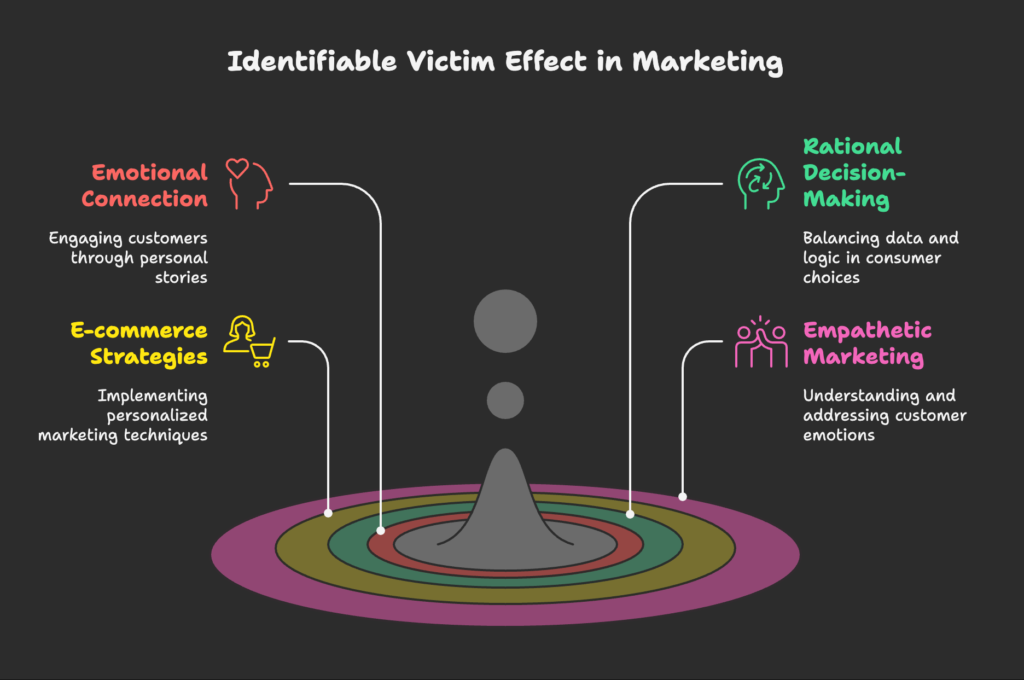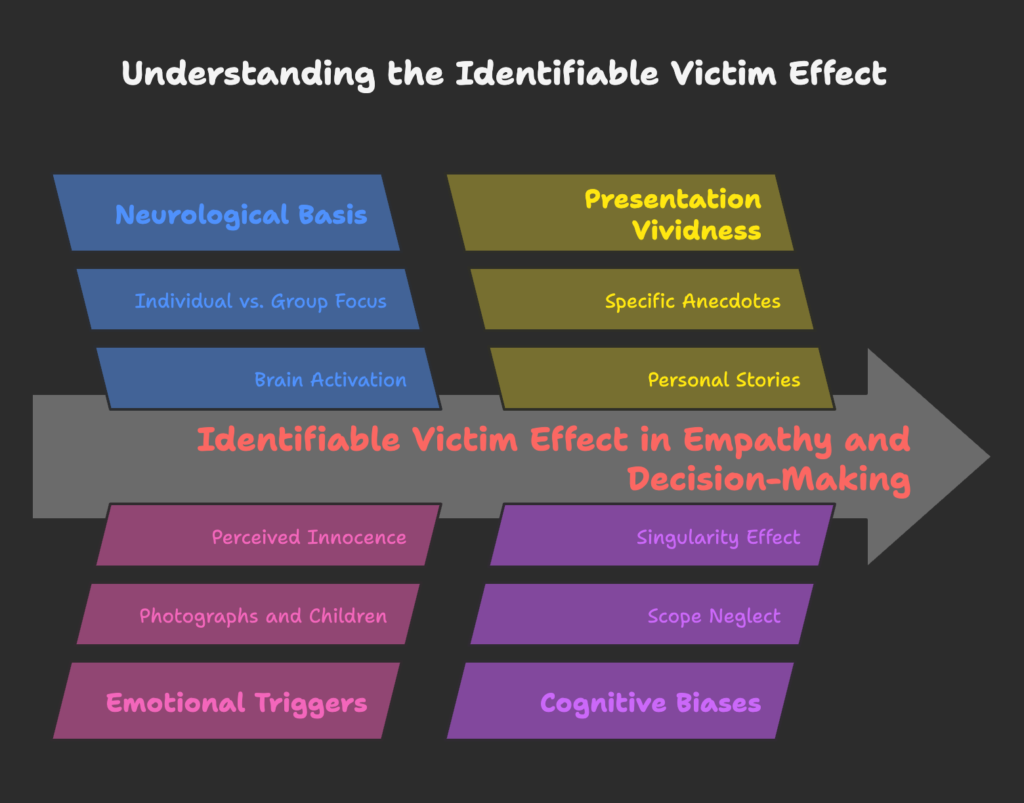Have you ever paused mid-scroll because a story tugged at your heartstrings? That’s exactly what the identifiable victim effect can do—stop you in your tracks and spark genuine connection. By the time you finish reading this article, you’ll know how to use personal storytelling to attract more shoppers, encourage deeper trust, and give your Shopify store a friendly, human touch. Ready to get started? Let’s jump right in!
Understanding the Identifiable Victim Effect
In this section, we’ll explore what the identifiable victim effect is and why it matters for your store. You’ll discover the core ideas behind it, how it works in the mind, and why it can be so powerful. Keep reading, and by the end of this part, you’ll understand the difference between focusing on one person’s story versus broad statistics. Then, we’ll see how emotions often override pure logic when people make buying decisions.

Definition and Core Concepts
The identifiable victim effect is the tendency for people to respond more strongly to a single, vivid story than to large, impersonal numbers. Put simply, if we can see or imagine a real person’s face, we feel more motivated to help or engage.
When you show shoppers a specific story or testimonial, you’re tapping into this effect. Instead of bombarding them with data, you share a personal narrative they can picture. This is where powerful emotional connections begin.
Psychological Foundations of the Effect
So why does it happen? Human brains evolved to react to individual stories, partly because we build emotional bonds more easily when we can identify a single figure. This is different from logical processes, where numbers and facts hold the spotlight. Emotions often take the lead, especially in quick decisions.
The Contrast Between Individual and Statistical Victims
If you talk about a large group, people might feel overwhelmed. It’s hard to grasp the needs of a thousand individuals at once. But if you focus on one person, with a name and face, your audience can connect on a deeper level. In e-commerce, that translates into showing a single customer’s transformation or success story rather than abstract ratings.
Emotional vs. Rational Decision-Making in Consumer Behavior
Feelings can steer behavior more than facts can. While data is useful, an emotional pull often wins the moment. Shoppers might “justify” their choice logically later, but it’s often the heart that moves first. Understanding this dynamic opens the door to more empathetic marketing strategies.
We’ve covered what the identifiable victim effect is, why it matters, and how emotions can overshadow pure logic. Next, we’ll look at the science behind it. Get ready for an intriguing look into brains, empathy, and more!
The Science Behind the Identifiable Victim Effect
Now, let’s look at how our minds respond to personal stories. By the end of this section, you’ll see how pictures, innocence, and memorable details can create stronger connections.

We’ll also touch on how this effect links with other cognitive biases. Stay tuned for an eye-opening perspective on what triggers empathy.
Neurological Basis of Empathetic Response
Research suggests that certain parts of our brain light up when we see or hear about a real person’s situation. This reaction doesn’t happen as strongly when we deal with large groups or abstract figures. The reason? Our minds are wired to care about individual lives we can picture, which is why a single heartwarming photo can speak louder than a giant spreadsheet of statistics.
Factors Enhancing the Effect (Photographs, Children, Perceived Innocence)
Images, especially those of children or individuals who appear vulnerable, make the emotional bond stronger. Shoppers often feel a desire to help or reward a person who seems genuine and relatable. When you include a personal story with a clear photograph, you’re likely to inspire more trust and empathy.
The Role of Vividness in Creating Connections
Bright details, such as a person’s name or a specific anecdote, bring the story to life. This vivid presentation helps shoppers imagine themselves or someone they care about in the same situation. That connection can prompt a stronger urge to click “Buy” or “Support.”
Reference Group Size and Its Impact on Response
When a story focuses on one or two people, it feels manageable. If it talks about hundreds of individuals, it loses some of that personal touch. Shoppers can feel overwhelmed or disconnected from the large group and may not respond as kindly.
Relationship to Other Cognitive Biases (Scope Neglect, Singularity Effect)
The identifiable victim effect often links with scope neglect (where the size of a problem doesn’t affect how much people care) and the singularity effect (where one case can seem more pressing than many). These biases show how emotional triggers sometimes beat logical reasoning.
Now that you know the brain science behind why we respond so strongly to a single story, you’re probably curious about how this concept fits into online shopping. Let’s move on and see how e-commerce can benefit from this effect.
The Identifiable Victim Effect in E-commerce
In this section, we’ll see how ideas from charitable giving translate to online stores. You’ll learn how trust can grow when you focus on personal stories, and we’ll look at real examples of businesses that have used these strategies. By the end, you’ll see why the customer’s emotional journey is just as important as any coupon code.
Translating Charitable Giving Principles to Commercial Settings
Charities have long used personal stories to inspire donations. E-commerce brands can do something similar by sharing customer experiences or introducing team members in a relatable way. This approach moves shoppers from thinking, “Why should I buy?” to feeling, “I want to support someone’s journey.”
How Consumer Psychology Shifts in Online Environments
Without face-to-face interaction, online shoppers rely on images, text, and reviews to build trust. Personal narratives fill that gap by adding real, human moments to your product pages. These stories can help people feel comfortable enough to press the “Add to Cart” button.
Building Trust Through Personalization in E-commerce
When you address your buyer by name in emails or recommend products based on their preferences, you give them a sense of being seen. That small personal touch can mean a lot, especially when combined with a story about someone who overcame a problem using your solution.
Case Studies of Successful Implementation
Many online brands have seen an increase in shopper engagement after adding a personal story on their homepage. Some run campaigns showing real customers who achieved results using a product. These case studies capture attention, create emotional connections, and boost conversions.
By now, you understand how personal appeals can shift the buying mindset. Next, we’ll look at practical ways you can bring these ideas to life on Shopify.
Implementing the Identifiable Victim Effect on Shopify
Get ready to see how testimonials, product narratives, and email marketing can come together to form a powerful strategy. By the end of this section, you’ll know how to make your store feel more personal, trustworthy, and relatable.
Customer Testimonials and Success Stories
One of the easiest ways to use the identifiable victim effect is by featuring real customers on your store. Show who they are, what they needed, and how you helped. Include quotes and before-and-after snapshots if possible. This encourages visitors to say, “That could be me!”
Product Page Optimization Using Personal Narratives
Instead of just listing features, share short stories. Mention how someone solved a daily challenge thanks to a product. Make it quick yet vivid. This approach can create a bond that goes beyond specs and pricing.
Visual Storytelling Techniques for Product Presentation
Pictures and videos that highlight a single, recognizable person can be more appealing than generic product shots alone. For example, a photo of a smiling customer wearing your jewelry or trying out your gadget can be the difference between a glance and a click.
Personalized Email Marketing Campaigns
Want to stand out in a crowded inbox? Send an email that addresses your reader by name and includes a personal story or testimonial. Keep it friendly and short. The emotional element can make subscribers actually read your message, not just scroll past it.
Creating Emotional Connections Through User-Generated Content
Encourage customers to share their experiences through photos and short statements. Highlight these stories on social media and your site. When people see others enjoying a product, they may trust your brand more. Personal content like this can be a powerful magnet for attention and loyalty.
At this point, you have a good sense of how to introduce the identifiable victim effect into your Shopify store. Wondering how to take it further? Let’s explore some advanced personalization tactics next.
Advanced Personalization Strategies
Here, we’ll discuss how to tailor your messages to different customer groups, use AI to make one-on-one experiences, and keep everything real without crossing any lines. By the end, you’ll know how to measure what’s working and how to protect people’s data while you customize.
Segmentation for Targeted Personal Appeals
Grouping your audience by interests or behaviors helps you offer the right story to the right person. For instance, if you know someone loves eco-friendly products, share a mini-journey of an eco-conscious user who found success with your items.
Using AI to Deliver Individualized Experiences
Artificial intelligence can study patterns and suggest product bundles or content relevant to each visitor. When done well, this feels friendly, not intrusive. It helps shoppers see that you understand their tastes, turning casual browsing into a more welcoming experience.
Balancing Personalization with Privacy Concerns
It’s good to remember that people value their privacy. Be clear about how you collect and use their information. An open policy helps maintain trust and prevents any uneasy feelings.
Creating Authentic Connections Without Manipulation
Always keep your storytelling honest. Authenticity is a must. If people sense anything overly dramatic or fake, you can lose respect quickly. Keep it genuine and respectful of your audience’s feelings.
Measuring the Impact of Personalization Efforts
Track data such as click-through rates, average time on page, and conversions. You might also run short surveys to gather feedback. Together, these insights let you know if your personalized stories are truly hitting the mark.
You’ve now got a solid toolset for advanced personalization. But how do you put it into words and images effectively? Let’s find out in the next section.
Designing Effective Personal Appeals
Now we’ll talk about how to shape individual stories, find the right images, and choose the best language for your audience. By the end of this section, you’ll know how to balance emotion and practicality, plus test different approaches to see what works best.
Crafting Interesting Individual Stories
Think about how you’d tell a friend about a satisfied customer. That’s the tone to aim for. Keep it short but rich in details that matter. Share the person’s main struggle and how your solution helped, so readers feel like they’re stepping into that story.
Visual Elements That Enhance Personal Connection
Images or short videos of a single smiling customer are often more memorable than product images alone. Show real people. Show their expressions. These visuals can quickly build empathy and spark curiosity.
Language and Tone Considerations
Keep your wording welcoming, clear, and casual. Avoid heavy technical language or “hard sell” phrases. The goal is to make your reader feel comfortable, not pressured. Use a friendly, warm voice so they see you as a helpful guide, not a distant brand.
Balancing Emotional Appeal with Product Information
While tapping into emotions is powerful, shoppers still need key facts about your product. Provide the details they need, but do it in a way that complements the storytelling. A brief side note or bullet list can be helpful here.
A/B Testing Frameworks for Personal Appeals
Try different story lengths, photographs, or calls to action. Check the metrics to see which ones get more clicks or lead to more sales. Experimenting this way ensures you keep refining until you find the perfect recipe.
You’re now equipped to write, illustrate, and test personal appeals. Let’s move on to the final considerations for staying true to your brand values while using these methods.
Ethical Considerations and Best Practices
This section is all about keeping your marketing real. You’ll learn how to avoid manipulation, consider different cultures, and plan for lasting relationships rather than quick sales. By the end, you’ll have a blueprint for honest personalization.
Avoiding Manipulation and Maintaining Authenticity
A story that feels forced or exaggerated can backfire. Keep it genuine, respecting your audience’s ability to sense when something isn’t real. Focus on real experiences, honest endorsements, and content that reflects your brand’s true nature.
Transparency in Personalized Marketing
Explain how and why you collect data. If you use automated methods or track certain behavior, let people know. This open approach helps users understand that personalization is there to serve them, not trick them.
Cultural Sensitivity in Personal Narratives
A story that works in one region might not work in another. Be aware of cultural values and norms. Test your messages with different audience segments to ensure you’re being respectful and relevant.
Long-term Relationship Building vs. Short-term Conversions
Quick sales can be nice, but long-lasting customer loyalty is even better. Show that you care about your customers as people, and they’ll often stick with you. Personal stories and genuine interactions can lead to stronger bonds and repeat business.
Developing an Ethical Framework for Personalization
Write down clear guidelines for how you use personalization in your business. Review them often to make sure you stay on track. If in doubt, put yourself in the customer’s shoes and ask if the message would feel honest and fair.
Armed with these best practices, you’re ready to see real-world examples and success stories. Let’s move ahead to see how others have applied these principles.
Case Studies and Success Stories
We’re about to check out actual examples of how businesses of different sizes have used personal connection to boost sales. By the end of this part, you’ll see how these ideas can work for you, no matter your niche or market size.
Small Business Transformations Through Personal Connection
Some small shops have reported that sharing a single customer’s story on their homepage increased their sales by a noticeable margin. Customers trust these human experiences and feel motivated to buy from someone who genuinely understands them.
Enterprise-Level Implementation of Personalization
Bigger corporations often use data analytics and AI to show the right story to the right audience. These companies might have teams dedicated to collecting user stories and turning them into sleek marketing pieces. The principle is the same: one person’s story can move a crowd.
Niche Market Applications
From handmade crafts to vegan snacks, personal appeals work in almost any niche. Sharing a personalized review or unique journey can attract people who identify with that story. This approach brings in high-quality leads who already believe in your product’s value.
Quantifying Results and ROI
Whether it’s click-through rates or repeat customer counts, businesses often see improvements when they put real faces and stories front and center. Seeing the direct impact on profit helps justify investing in personal narratives and storytelling techniques.
Lessons Learned and Common Pitfalls
Some brands have gone overboard or fabricated details to make a story more exciting. This can lead to mistrust and hurt sales. The best advice? Keep it genuine, keep it respectful, and always remember that you’re talking to real people.
Now that you’ve seen how real brands benefit from personal connections, let’s look at where these trends are headed in the near future.
Future Trends in Personalization
In this section, we’ll talk about AI, immersive technologies, and more ways to keep human touches alive. By the end, you’ll have a clear idea of how online shopping might evolve and how you can stay ahead of the curve.
AI and Machine Learning Applications
New tools can gather information about individual shoppers to tailor experiences even more. From recommending items to predicting the perfect timing for an email, AI is becoming a key player in personalization.
Immersive Technologies (AR/VR) for Personal Connection
Some stores are experimenting with augmented reality (AR) or virtual reality (VR) to help customers feel like they’re part of a shared story. Seeing how a product fits into everyday life—almost as if you’re there—can deepen the sense of personal involvement.
Voice and Conversational Commerce Personalization
Voice assistants can greet shoppers by name and offer personal tips based on past orders. Conversational commerce like this is still growing, but it’s another way to highlight a single person’s needs instead of random recommendations.
Cross-Channel Personalization Strategies
A shopper might see your brand on social media, your website, and in emails. Cross-channel personalization ensures these experiences feel unified and consistent. A story started on Instagram could continue in an email or retargeting ad.
Balancing Automation with Human Touch
While automation saves time, it’s important to keep a human feel in your interactions. Some tasks can be handled by chatbots or automated emails, but adding a genuine reply or a real person’s video can make all the difference.
Excited about the future of personalization? Let’s see how you can put these trends into action with a step-by-step guide for Shopify.
Implementation Guide for Shopify Merchants
This final section gives you a roadmap to bring everything together. By the end, you’ll have a clear plan for using the identifiable victim effect, picking the right tools, and scaling as you grow.
Step-by-Step Implementation Plan
- Define Your Story: Pick a core narrative that captures your brand’s values.
- Gather Real Stories: Ask your customers for short testimonials or personal details that highlight their experience.
- Design Personal Pages: Update product pages with these stories. Include photos or quotes for added impact.
- Personalize Marketing: Tailor emails, pop-ups, and ads with individual names and stories.
- Measure & Refine: Track results and adjust your strategy based on what resonates most with shoppers.
Recommended Shopify Apps and Tools
Look for review collection apps or personalization plugins that allow you to tag real customer stories. Some apps also provide AI-driven suggestions for cross-selling and upselling based on user behavior.
Resource Requirements and Considerations
You might need a small budget for professional photography or simple video production if you want to showcase real people. Remember to get permission before sharing anyone’s story or image.
Measuring Success and Optimization Framework
Keep an eye on key metrics like conversion rate, average order value, and returning customer rate. Use A/B tests to find which stories or images produce the best results, then build on those findings.
Scaling Personalization as Your Business Grows
As your store expands, so can your personal appeals. Gather more customer stories, try new segmentation, and add updated photos or videos. Continue refining the process so it remains fresh and engaging.
References
- Wikipedia. (2024). Identifiable victim effect. https://en.wikipedia.org/wiki/Identifiable_victim_effect
- Patent355. (n.d.). Behavioral Design: Identifiable Victim Effect. https://www.patent355.com/behavioral-design-glossary/identifiable-victim-effect
- Zhang, Y., Slovic, P., Geiger, M., & Götz, F. M. (2024). Revisiting and Rethinking the Identifiable Victim Effect: Replication and Extension of Small et al. (2007). Collabra: Psychology, 9(1), 90203. https://online.ucpress.edu/collabra/article/9/1/90203/199223/Revisiting-and-Rethinking-the-Identifiable-Victim
- Jenni, K., & Loewenstein, G. (1997). Explaining the “Identifiable Victim Effect”. Journal of Risk and Uncertainty, 14, 235-257.
- Small, D. A., & Loewenstein, G. (2003). Helping a victim or helping the victim: Altruism and identifiability. Journal of Risk and Uncertainty, 26(1), 5-16.
- Kogut, T., & Ritov, I. (2005). The “identified victim” effect: An identified group, or just a single individual? Journal of Behavioral Decision Making, 18(3), 157-167.
- The Decision Lab. (2021). Identifiable Victim Effect. https://thedecisionlab.com/biases/identifiable-victim-effect
Ready to supercharge your Shopify store’s sales with perfectly optimized discount codes? Growth Suite is a Shopify app that helps you do just that. Install it with a single click and start seeing results!




